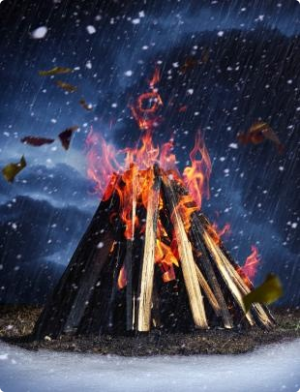It's often when you need a fire most—during rain, wind, or snow—that it's the hardest to start. Here's how to do it.
It's an axiom of survival that when you need a fire—really need it with the snow blowing and the evening drawing down like a burial shroud—you need it now. And you need it big.
No futzing around with a bow drill. No trying to spark fire with a rock and a hunting knife. No miniature sparking wheel that will fumble out of your numb fingers. What you need are no-b.s. methods to ignite fire, utilize tinder, render kindling, and gather enough fuel to keep hypothermia at bay. And you need them in the opposite order, because the secret of generating a warming fire is to build it from the outside in.
Start Big
First order of business is gathering fuel. Doing so will warm you up so you have steady hands to actually start the fire later on. Plus, it will be harder to find once it's dark. How much? For an all-night fire, a stack of logs as long as you are tall and waist-high. With an ax, you can lay in a supply by toppling one standing dead tree. No ax and you'll have to haul in deadfall and break it into reasonable lengths by wedging the ends between two trees and pulling. Don't neglect burned stumps, which are full of pitch, and for every three dry logs haul in one green one. It will burn once the fire is established.
Tip: Pack pigskin work gloves. Wool or fleece hunting gloves will shred under the demands of gathering fuel, leaving you with mangled fingers to try to start a fire.
Get to the Heart
Gathering kindling can be as simple as breaking off the dead twigs and branches that quill the lower trunks of spruce and pine trees; these stay dry because they are protected by canopy. But in country where you hunt in your rain gear, the only dry source of kindling will be the heartwood of standing dead and propped logs. Saw or chop the trunk into sections and then split the dry inner wood into sticks ranging from pencil- to wrist-thickness. You'll need a bundle of splits about as big as you can hug to your chest to establish a fire hot enough to burn larger fuel.
Tip: No ax? Pound on the spine of your knife to split off a wedge of wood. By placing a series of wedges in a crack that runs lengthwise along a log and pounding on them with a stout stick, you can split the trunk to expose the dry interior.
Sweat the Small Stuff
A snowstorm is no time to look for fungus or dry grass. Bring tinder with you. Cotton balls smeared with petroleum jelly are as good as anything you can buy. Make a softball-size nest of bark shavings, rusted pine needles, and feathered wood from your kindling splits, place the tinder on it, then loosely cover the tinder with more needles and shavings. Build a tepee from your kindling around the tinder, starting with the tiny twigs and working your way up to kindling as thick as your thumb.
Tip: For insurance, I pack a finger-size stick of resin-soaked fatwood (pine). It provides long-lasting tinder for igniting kindling in wet weather.
Light It Up
Forget those windproof matches that require a chemical reaction to ignite. Gum up the striking strip and they might as well be toothpicks. The best sources of ignition in really bad weather are a butane lighter that provides a tall, strong flame and a sparking steel that will throw a shower of white-hot sparks and the wind be damned. Carry both.
Tip: The sparking steel I use includes a magnesium rod and is set into a wooden handle, both of which can be shaved off and used as tinder.
Once you have the tepee fire blazing, cross it with your wrist-thick kindling and start to add larger fuel. A warming fire should be as long as your body and backed by a wall of logs or rocks to reflect the heat back at you. Once it's established, add a few green logs, which burn with fewer BTUs than dry logs but last longer, ensuring that you will outlive the moon for at least one more night.

